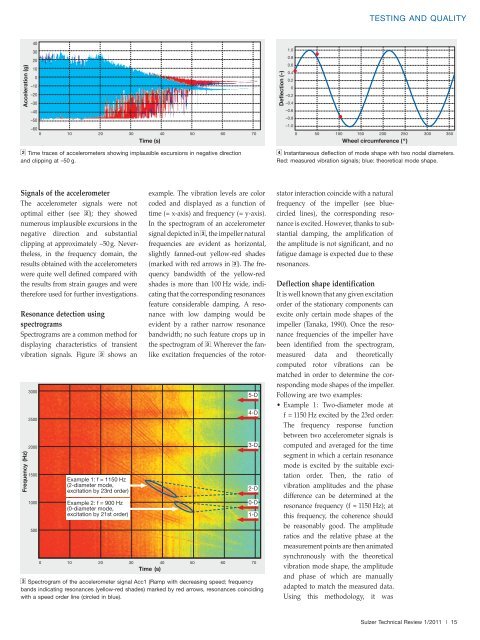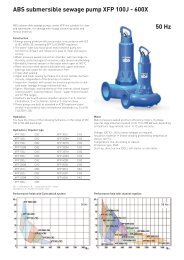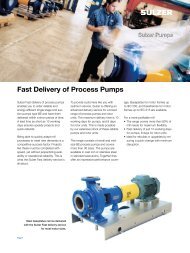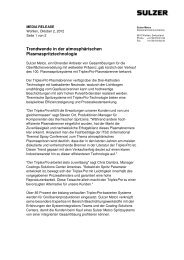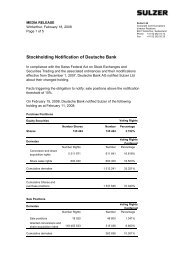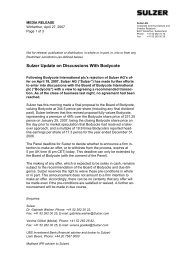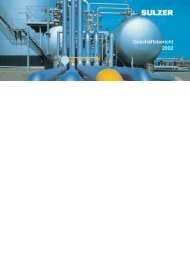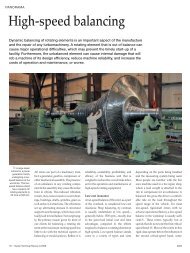Testing and quality
Testing and quality
Testing and quality
Create successful ePaper yourself
Turn your PDF publications into a flip-book with our unique Google optimized e-Paper software.
Acceleration (g)<br />
40<br />
30<br />
20<br />
10<br />
0<br />
–10<br />
–20<br />
–30<br />
–40<br />
–50<br />
–60<br />
0 10 20 30 40<br />
Time (s)<br />
50 60 70<br />
2 Time traces of accelerometers showing implausible excursions in negative direction<br />
<strong>and</strong> clipping at –50 g.<br />
Signals of the accelerometer<br />
The accelerometer signals were not<br />
optimal either (see 2); they showed<br />
numerous implausible excursions in the<br />
negative direction <strong>and</strong> substantial<br />
clipping at approximately –50g. Nevertheless,<br />
in the frequency domain, the<br />
results obtained with the accelerometers<br />
were quite well defined compared with<br />
the results from strain gauges <strong>and</strong> were<br />
therefore used for further investigations.<br />
Resonance detection using<br />
spectrograms<br />
Spectrograms are a common method for<br />
displaying characteristics of transient<br />
vibration signals. Figure 3 shows an<br />
2500<br />
2000<br />
1500<br />
Frequency (Hz) 3000<br />
1000<br />
500<br />
Example 1: f = 1150 Hz<br />
(2-diameter mode,<br />
excitation by 23rd order)<br />
Example 2: f = 900 Hz<br />
(0-diameter mode,<br />
excitation by 21st order)<br />
example. The vibration levels are color<br />
coded <strong>and</strong> displayed as a function of<br />
time (= x-axis) <strong>and</strong> frequency (= y-axis).<br />
In the spectrogram of an accelerometer<br />
signal depicted in 3, the impeller natural<br />
frequencies are evident as horizontal,<br />
slightly fanned-out yellow-red shades<br />
(marked with red arrows in 3). The frequency<br />
b<strong>and</strong>width of the yellow-red<br />
shades is more than 100 Hz wide, indicating<br />
that the corresponding resonances<br />
feature considerable damping. A resonance<br />
with low damping would be<br />
evident by a rather narrow resonance<br />
b<strong>and</strong>width; no such feature crops up in<br />
the spectrogram of 3. Wherever the fanlike<br />
excitation frequencies of the rotor-<br />
0 10 20 30 40<br />
Time (s)<br />
50 60 70<br />
5-D<br />
3 Spectrogram of the accelerometer signal Acc1 (Ramp with decreasing speed; frequency<br />
b<strong>and</strong>s indicating resonances (yellow-red shades) marked by red arrows, resonances coinciding<br />
with a speed order line (circled in blue).<br />
4-D<br />
3-D<br />
2-D<br />
0-D<br />
1-D<br />
Deflection (–)<br />
1.0<br />
0.8<br />
0.6<br />
0.4<br />
0.2<br />
0<br />
–0.2<br />
–0.4<br />
–0.6<br />
–0.8<br />
–1.0<br />
stator interaction coincide with a natural<br />
frequency of the impeller (see bluecircled<br />
lines), the corresponding resonance<br />
is excited. However, thanks to substantial<br />
damping, the amplification of<br />
the amplitude is not significant, <strong>and</strong> no<br />
fatigue damage is expected due to these<br />
resonances.<br />
Deflection shape identification<br />
It is well known that any given excitation<br />
order of the stationary components can<br />
excite only certain mode shapes of the<br />
impeller (Tanaka, 1990). Once the resonance<br />
frequencies of the impeller have<br />
been identified from the spectrogram,<br />
measured data <strong>and</strong> theoretically<br />
computed rotor vibrations can be<br />
matched in order to determine the corresponding<br />
mode shapes of the impeller.<br />
Following are two examples:<br />
• Example 1: Two-diameter mode at<br />
f=1150 Hz excited by the 23rd order:<br />
The frequency response function<br />
between two accelerometer signals is<br />
computed <strong>and</strong> averaged for the time<br />
segment in which a certain resonance<br />
mode is excited by the suitable excitation<br />
order. Then, the ratio of<br />
vibration amplitudes <strong>and</strong> the phase<br />
difference can be determined at the<br />
resonance frequency (f = 1150 Hz); at<br />
this frequency, the coherence should<br />
be reasonably good. The amplitude<br />
ratios <strong>and</strong> the relative phase at the<br />
measurement points are then animated<br />
synchronously with the theoretical<br />
vibration mode shape, the amplitude<br />
<strong>and</strong> phase of which are manually<br />
adapted to match the measured data.<br />
Using this methodology, it was<br />
TESTING AND QUALITY<br />
0 50 100 150 200 250 300 350<br />
Wheel circumference (º)<br />
4 Instantaneous deflection of mode shape with two nodal diameters.<br />
Red: measured vibration signals; blue: theoretical mode shape.<br />
Sulzer Technical Review 1/2011 |<br />
15


